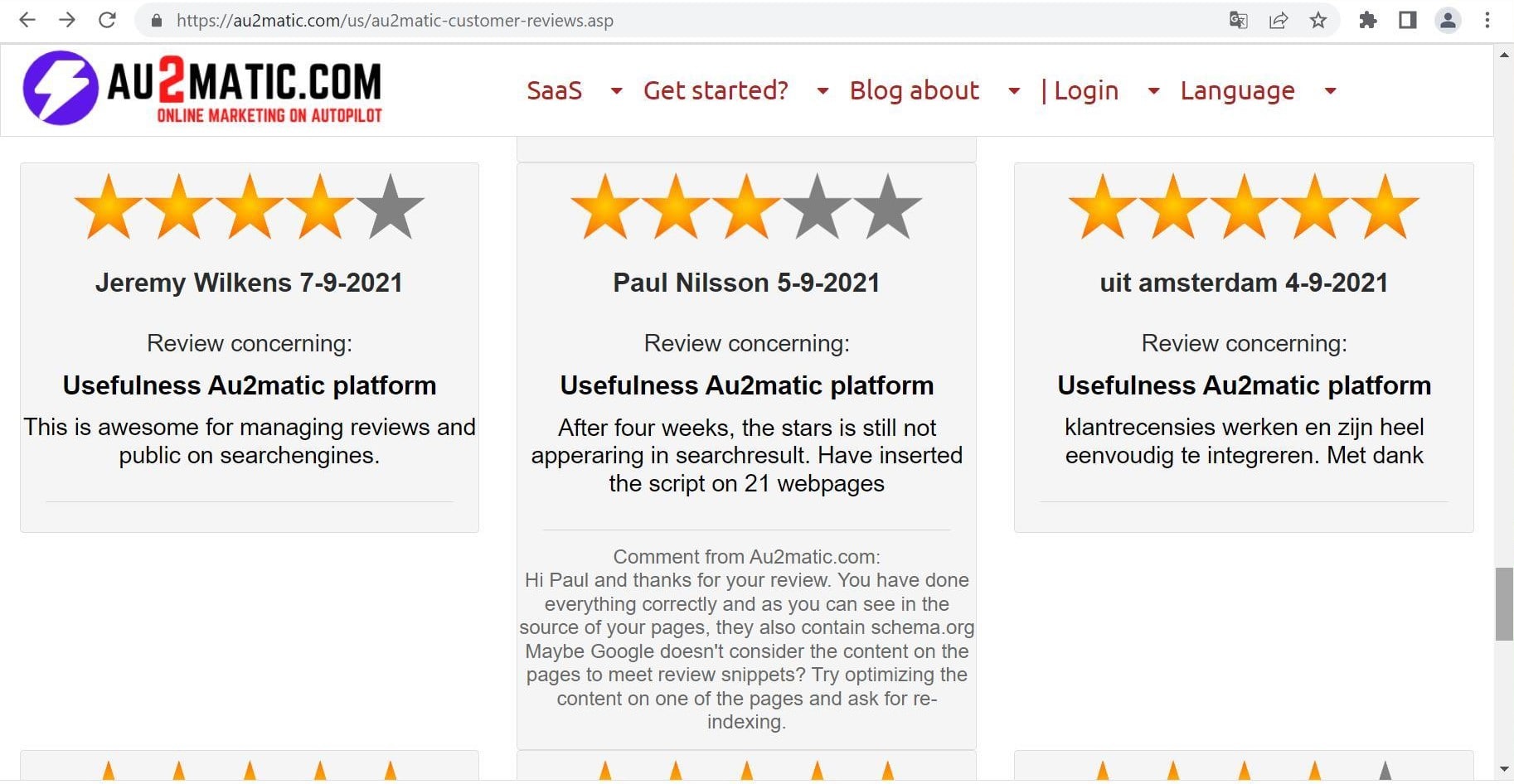- SaaS
-
Get started?
Get started?
- Start for free
- See user ratings
-
Blog about
Blog about
- Success online
- | Login
- Language




My research led to articles about the Blemishing effect - the complementing effect - and I slowly began to understand why this concept is so important to master within online marketing, reputation management and review marketing.
In a study led by two Stanford professors, they tested this effect on two groups of consumers by presenting a pair of hiking boots:
First group: Shown only the positive reviews accumulated.
Second group: Was shown the positive reviews and a summary of the negative, or "bad reviews", accumulated..
The result: The second group was 20% more interested in buying the boots.
Why did showing "bad reviews" increase interest? For 3 very simple reasons, according to the study:
1. The Power of Contrast - several studies have shown that the difference between 1 and 10 is perceived as greater than the difference between 0 and 10. Similarly, by adding one negative review (instead of 0), we increase the positive aspects of the boot and has a stronger positive effect.
2. Increased credibility – when - we as consumers - see a mixture of positive and negative reviews, we believe more strongly in the company's credibility and assume that they are telling us the whole story. This makes it easier for us to trust them, like them and buy from them.
3. Confirmation bias – tendency to accept information that supports the hypotheses or attitudes people already have. When students are initially introduced to the positive reviews of the hiking boots, they are likely to adapt and even emphasize them when they are shown and see the negative ones. Or make their positive perception of the product even stronger.
But enough about studies and experiments. Instead, let's get specific about what you can use it for in your business and in your online marketing.
The conclusion, on mixing positive and negative customer reviews, must be:
Positive customer reviews are and will be the most important.
When you start with the positive, you induce confirmation bias. So when customers see the "mixed" reviews, they will not only justify the negative by referring to the positive they read or perceived before, but end up intensifying their taste, appetite and trust in your service or product.
Include and display a sample of the "bad reviews"
Others call it "The perfect" to master online... You can advantageously find a median of the "bad" or negative reviews - for example you can select the "not extreme" ones, it could be the 3-star ones, but omit those with one and two stars. In some of the Reputation Management systems, you can also switch between which ratings are to be included. If the two stars, for a period, have ok comments, even though they are two stars, then maybe they should be shown in this period? The research shows, for example, that a restaurant with good food and parking problems gets really nice two and three stars, so it looks different for a restaurant with "bad food" and good parking!
Effective reputation management and profitable marketing of customer reviews consists of 3 elements:
1. The collection of customer reviews
We need the customers or visitors to the website - preferably both - to tell us about their experience. It is the entire foundation within Review Management and Review marketing. And perhaps also the most difficult element because it has to be easy. It is difficult to get consumers to speak if they have to log in, as is the case with Trustpilot and Google My Business.
We have done many tests and surveys ourselves to find out how to get the most customer reviews. Our studies show that if you have bought a house or a car, you would prefer to avoid being identified - in other words, you would like to give your assessment but preferably neutrally, and the same applies if you have bought for a small amount - here you go you don't spend a lot of time.
Whether you want to collect customer reviews via Trustpilot, Google My Business, Facebook or something else entirely is your choice. The most important thing is the collection and that it is possible to market the results afterwards. My recommendation is to "become master of your own house", i.e. create your own website where customers can submit their reviews. And it doesn't have to be particularly complicated or cost a lot of money. Au2matic.com makes it easy - very easy.
Here you can see how au2matic.com collects customer reviews on its own website via a script.
Here is an example of one-click customer reviews via au2matic.com - below on this website you can try it live!

2. The control and answers
It is calles Reputation management. This article is about "bad reviews" and the fact is none of us can do business without some customers being unhappy? In my online marketing circle of friends, we talk about "the notorious losers", i.e. those who, after a charter holiday, give 1 star because the weather was bad and maybe on top of that demand money back or a discount. They must be allowed to do so, but on external platforms such as Trustpilot, Yelp, Podium, Facebook and Google My Business, they are complicated to handle and remove if necessary.
If you are aware of what I mentioned before - i.e. no one can run a business without some customers being dissatisfied - and remember that the negative customer reviews are really just as important as the positive ones - then it is all about the management and commenting on the bad ones reviews. In other words, to "grab the long end"!
Why can't you submit your review without logging in to Trustpilot, Google My Business etc.? Because no one must be able to answer or submit their review without identifying themselves and comments must be addressable. Again a fact that makes me opt out of the review platforms. When customer reviews are integrated on your own website and collected in your own database, you get the opportunity to comment on reviews from customers who have wished to be neutral.
When the negative or bad customer reviews are shown together with many positive customer reviews (the Blemishing Effect), they do not seem so negative and if you make sure to comment on them, even the anonymous ones, then the reputation is completed and the negative becomes positive!
Just look here…

3. Display and marketing on search engines and own websites
Regarding the marketing of customer reviews, remember that the COVID lockdown has caused online to offline to merge. Today, 80% start their search online and if you have a physical store, some will physically come to the store and shop and others will shop online. Hence the concept of ROPO (Research Online Purchase Offline) arose.
80% of your new customers find your business, product or service online, this also means that 80% of your new customers start on Google or Bing. Therefore, it makes good sense, better profit, extra SEO and significant SERP to show the rating (stars) already in the search results on the search engines. Technically, this is done using Rich snippets on the web pages. Here too, au2matic is a profitable platform.
In addition, of course, customer reviews must be displayed on all websites that present products and services, and in this connection it is important to remember the Blemising effect. Au2matic.com makes it easy because you can copy finished scripts.
Hope you found this article insightful and that you are starting or getting started now with Reputation Management and Review Marketing.


